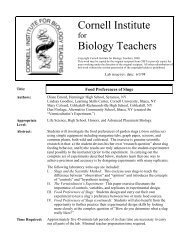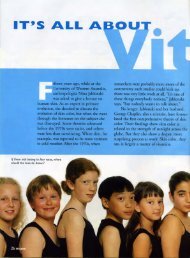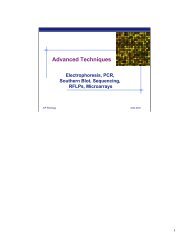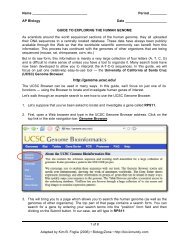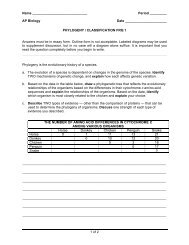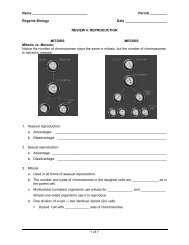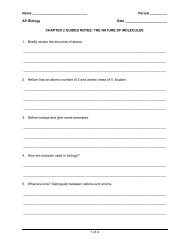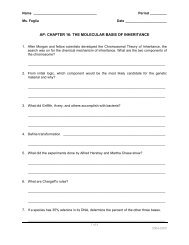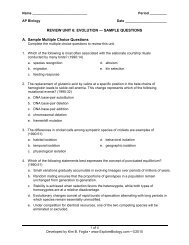lab ____. classification & dichotomous keys - Explore Biology
lab ____. classification & dichotomous keys - Explore Biology
lab ____. classification & dichotomous keys - Explore Biology
Create successful ePaper yourself
Turn your PDF publications into a flip-book with our unique Google optimized e-Paper software.
Name _____________________________Living Environment / <strong>Biology</strong>Period _________Date ______________________LAB ____. CLASSIFICATION & DICHOTOMOUS KEYSAs we have discussed in class, with the help of Carolus Linnaeus, scientists have developed ahierarchical organizing and naming system for all organisms — from Kingdom all the way downto Genus and Species. They have also detailed the characteristics by which organisms areclustered into those groups. For example, all organisms which are warm-blooded, have hair,give birth to live young, and produce milk are considered Mammals.Now that we have this organized system, we can classify all living creatures into these groups.And we also can use the characteristics and groups to identify unknown specimens. Like “Whatbird is that?” or “What kind of bug is thatHow does one go about identifying the species, genus, etc., of a specimen whose identity isunknown (to the person who wishes to identify the specimen)? The most useful tool for suchidentifications is the <strong>dichotomous</strong> <strong>classification</strong> key. A <strong>dichotomous</strong> key contains informationuseful in identifying unknown organisms, and is arranged in a way that allows the information tobe used quickly. It is the most widely used type of key in biological sciences.In a <strong>dichotomous</strong> key, the user is presented with a sequence of choices between pairedstatements based on characteristics of the organism. By always taking the correct choice theidentity of the organism will eventually be revealed. Let’s begin with a brief exercise to illustratethis.1 of 6Adapted from a <strong>lab</strong> originally developed by Michael Comet, South Lewis High School, Turin, NY
Name _____________________________Living Environment / <strong>Biology</strong>FRUIT IDENTIFICATIONWe will practice using a <strong>dichotomous</strong> key with some items we are familiar with: fruit.To use a <strong>dichotomous</strong> key, one begins with the first couplet of paired statements, decidingwhich statement is true for a specimen. The key may then tell you what organism or group youhave, or it may direct you to another couplet. Choose the fruits at your <strong>lab</strong> bench one at a timeand follow the key until you have arrived at an identification for each.1a. Fruits occur singly ........................................................................... Go to 31b. Fruits occur in clusters of two or more ........................................... Go to 22a. Fruits are round ................................................................................ Grapes2b. Fruits are elongate .........................................................................Bananas3a. Thick skin that separates easily from flesh .................................. Oranges3b. Thin skin that adheres to flesh ........................................................ Go to 44a. More than one seed per fruit .............................................................Apples4b. One seed per fruit ............................................................................ Go to 55a. Skin covered with velvety hairs ..................................................... Peaches5b. Skin smooth, without hairs ................................................................PlumsNote that the overall organization of the key is very important. One cannot simply read through akey to find characteristics that apply to a specimen. For example, statement 3a above (thick skinthat separates easily from meat) is true of both oranges and bananas. Correct identification ofbananas depends on couplet number 1, which separates clustering vs. non-clustering fruits.You must walk through a <strong>dichotomous</strong> key step-by-step and not jump around until the key tellsyou to.2 of 6Adapted from a <strong>lab</strong> originally developed by Michael Comet, South Lewis High School, Turin, NY
Name _____________________________Living Environment / <strong>Biology</strong>PROCEDURE1. Closely examine one of the drawings of a fish shown in your packet of fish diagrams.A <strong>lab</strong>eled diagram has been provided to help you become familiar with fish anatomy and theterms that describe fish anatomy. Please review it and refer to it throughout this <strong>lab</strong>.2. Pick a fish to identify in your packet of fish diagrams and then begin using the <strong>classification</strong>key by reading both statements listed under number 1.3. One of these statements should describe the fish you have chosen; the other should not.4. Refer to the number after the statement that fits your fish and look for that number lowerdown in the <strong>classification</strong> key.5. Again select the statement that describes the fish you picked. Continue through the key untilyou come to a name after one statement. This should be the name of the fish you picked.6. Use the key to identify the fish in your Fish Identification Packet.FOLLOW THIS EXAMPLE:Suppose you want to find the name of Fish 2. Look at the Classification Key on the next page.Note that each numbered item presents two possibilities. We see that our fish has no scales, orat least we cannot see any. So we choose item #1b. This refers us to number 12. So we skipdown the page to number 12. Our fish is not elongated or snakelike (item 12b), so this choicedirects us to go to number 13 of the key. The fish we are classifying has barbels (see the FishAnatomy Diagram supplied with your Fish Identification Packet) growing from its lips and the topof its head (item 13a), so this choice directs us to go to number 14 of the key. Since our fish hasa caudal fin that is rounded, and a blunt head, this choice directs us to the Bullhead Catfish.That becomes our identification.3 of 6Adapted from a <strong>lab</strong> originally developed by Michael Comet, South Lewis High School, Turin, NY
CLASSIFICATION KEY FOR COMMON FRESHWATER FISH OF NEW YORK STATEQuestionsIdentify/Go To1a. Body noticeably covered with scales 21b. Scales not covering body or too small to be seen 122a. Dorsal fin single 32b. Dorsal fins two or more, joined or separated 63a. Body more than four times as long as broad (top to bottom): front edge of4dorsal fin far back on body; mouth large, hinge back of eye3b. Body less than four times as long as broad: front edge of dorsal fin about5midway between head and tail; mouth not large, hinge in front of eye4a. Dark lines forming netted design on body: fins not spotted Pickerel4b. Body covered with yellow spots; fins spotted Northern Pike5a. Mouth turned downward: barbels absent; dorsal fin not elongated White Sucker5b. Mouth not turned downward: barbels present; dorsal fin elongated Carp6a. Two dorsal fins separated, the anterior spiny and the posterior soft 76b. Two dorsal fins united, forming an anterior spiny portion and a posterior soft8portion7a. Top of head concave, forming a hump in front of dorsal fin; dark vertical Yellow Perchbars on body7b. Top of head not concave, body sloping to dorsal fin and not forming aWalleyehump; dark blotches on body8a. Body more than three times as long as broad 98b. Body less than three times as long as broad 109a. Hinge of jaws behind the eye: notch between spiny and soft dorsal fin deepand nearly separating into two finsLarge MouthedBass9b. Hinge of jaws below the eye; notch between spiny and soft dorsal fin notnearly separating into two finsSmall MouthedBass10a. Mouth large, hinge below or behind eye 1110b. Mouth small, hinge in front of eye Bluegill11a. Five to seven spines in dorsal fin; dark spots forming broad vertical bars Pumpkinseedon sides, Red/orange earspot on gill covering11b. Ten or more spines in dorsal fin: sides flecked with dark spots Rock Bass12a. Body much elongated and snakelike: dorsal, caudal, and anal finsAmerican Eelcontinuous12b. Body not elongated and snakelike: dorsal, caudal, and anal fins separate;13adipose fin present13a. Barbels growing from lips arid top of head; head large and broad 1413b. Barbels lacking; head not large and broad 1614a. Caudal fin deeply forked; head tapering 1514b. Caudal fin rounded or slightly indented but not forked: head blunt Bullhead15a. Dorsal fin rounded at top: body silvery, speckled with black markings Channel Catfish15b. Dorsal fin long and pointed at too: body bluish-gray without speckles Blue Catfish16a. Caudal fin deeply forked: back not mottled and with few spots Atlantic Salmon16b. Caudal fin square or slightly indented; back mottled or spotted 1717a. Back and caudal fin spotted: broad horizontal band along sides Rainbow Trout17b. Back mottled with dark lines: caudal fin not spotted; fins edged with white Brook Trout4 of 6
Name _____________________________Living Environment / <strong>Biology</strong>Data: The following data were collected during this activity:Fish #1Identified asIdentification pathway(list numbers & letters separated by commas)234567891011121314151617185 of 6Adapted from a <strong>lab</strong> originally developed by Michael Comet, South Lewis High School, Turin, NY
Name _____________________________Living Environment / <strong>Biology</strong>1. Prepare your own key for the pine tree sample in the figure below. Use the same format asthe <strong>dichotomous</strong> <strong>keys</strong> you have seen in this <strong>lab</strong> page. These leaves (needles) in Figure 3(below) are all from different pine trees and are drawn life size. Note that each bundlecontains different numbers and lengths of leaves. Design a key which will classify each tree.You may use a ruler if necessary.Figure 3Scotch Pitch Austrian Jack White1A ________________________________________________________________________1B ________________________________________________________________________2A ________________________________________________________________________2B ________________________________________________________________________3A ________________________________________________________________________3B ________________________________________________________________________4A ________________________________________________________________________4B ________________________________________________________________________5A ________________________________________________________________________5B ________________________________________________________________________6A ________________________________________________________________________6B ________________________________________________________________________6 of 6Adapted from a <strong>lab</strong> originally developed by Michael Comet, South Lewis High School, Turin, NY



